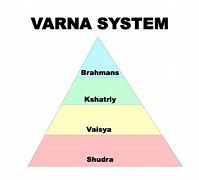
Tidak banyak negeri yang berwarna-warni seperti India. Merah, putih, dan oranye selalu menjadi warna Hinduisme yang menonjol dan dipakai secara teratur (terutama pada upacara keagamaan) di India selama lebih dari 2000 tahun. Tentu saja warna-warninya lebih dari tiga warna itu saja dan saya akan memberitahu Anda seputar hal ini…
Merah melambangkan kemurnian dan karenanya menjadi warna favorit busana pengantin wanita. Merah juga merupakan warna yang terkait dengan Durga, salah satu dewi yang paling disegani dalam mitologi Hindu. Gambarannya yang menakutkan itu antara lain muncul dari lidahnya yang merah dan kedua matanya yang nyaris merah total. Di India belahan selatan, merah merupakan warna kekerasan dan kekacauan.
kaum wanita duduk-duduk di tepi sungai Gangga, Varanasi
Putih merupakan warna yang mudah diterima pada pemakaman dan upacara-upacara yang terkait dengan kematian. (Saya pikir, warna ini jauh lebih baik daripada hitam.) Ini pun merupakan satu-satunya warna yang boleh dikenakan oleh para janda. Putih juga diterima secara luas (bukan hanya di India) sebagai warna kedamaian dan kemurnian.
potret seorang pria berbaju putih
Oranye adalah warna yang paling dominan di India. Warna oranye pada bendera India melambangkan keberanian dan pengorbanan. Menurut orang-orang Hindu, oranye melambangkan “cakra suci”. Cakra merupakan konsep yang berasal dari teks-teks agama Hindu.
pria-pria berbaju oranye di Varanasi sedang berjalan pulang dari sungai Gangga
Biru [muda] merupakan warna langit dan laut menurut indera penglihatan kita. Di India, warna biru ini terkait dengan dewa Krishna, salah satu dewa yang paling digemari di India. Yang paling terkenal dengan warna birunya di India adalah kota Jodhpur (terkenal dengan julukan “Kota Biru” atau “Kota Mentari”). Rumah-rumah berwarna biru berderetan. Kota ini berada di padang pasir Thar, yang bahkan membuatnya lebih mengesankan.
kain biru pada sebuah pasar di Gangtok
Hijau melambangkan panen, awal yang baru, dan kebahagiaan. Ini juga melambangkan alam dan karenanya merupakan perwujudan dari Tuhan itu sendiri. Hijau juga merupakan warna favorit orang-orang Islam, yang jumlahnya cukup besar di India.
seorang wanita berbusana Sari berwarna hijau di Varanasi
Kuning melambangkan kesucian dan merupakan unsur herbal mendasar untuk perawatan [kulit] tubuh dan wajah wanita India. Ini mengingatkan saya pada kari (curry).
bedak kari kuning pada sebuah pasar di Kolkata
Di India, hitam itu mengacu pada kenistaan dan hal-hal negatif lainnya. Warna ini melambangkan kemarahan dan kegelapan, serta terkait dengan kematian, kemandulan, dan ketiadaan energi. Warna ini digunakan sebagai reperesentasi dari setan dan untuk menangkal setan.
gagak-gagak hitam di depan balai penyembelihan di New Delhi
——- * Terjemahan dari Nina Maier, “The Colors of India”
diterjemahkan oleh Ma Sang Ji
PhD researcher: Sarita Bhagat
Humans and the more-than/non-human entities like the river, materials, and multi-variant species constantly interact creating and maintaining multiple realities. Framing rivers within the relational dynamics construct new meanings, values, norms, and knowledges in the physical, social, institutional, cultural, and political spaces which define ‘hydrosocial territories’. Powerful and dominant actors, often transcending national jurisdictions, create social norms and local rules, which to a varying degree lead to marginalization and loss of voice of other groups of actors, with less power, including the non-human entity. In this process of epistemic violence and silencing, important knowledges, meanings and information can be lost which are important to manage and govern rivers. This research will unravel these emergent relational dynamics in the context of the Warna watershed in India, to make space for other epistemologies animated by social justice, dynamics around social movements and river imaginaries to create and co-govern the Warna river commons, safeguarding rights of nature that go beyond the current legal frameworks in India. The overall research focuses on concepts emerging from political ecology, mainly focusing on notions of power relations and governmentality and actor-network theory. A qualitative research approach will be applied, with empirical and experiential field evidence to support my research, which includes creative and transformative learning methods to collect data.
aktivis Yayasan Patimadora Banda Aceh, melaporkan dari New Delhi
INDIA sering diagungkan dan dikenang sebagai negara penuh warna. Sebagai pendatang, saya sering takjub memperhatikan berbagai warna yang dengan mudah kita jumpai di jalanan, bangunan, pertokoan, aksesori, bahkan di berbagai halaman buku cerita rakyat kuno.
Aneka warna yang mencolok juga dengan mudah kita jumpai di tempat-tempat umum, tempat bertemunya pria dan perempuan cantik yang berpakaian khas India dalam berbagai warna. Ini pemandangan tak umum, pakaian tradisional dikenakan sebagai pakai sehari-hari. Lengkap dengan aksesori yang warna-warni. Bahkan warna-warna tertentu mendominasi upacara-upacara tradisi, antara lain, merah dan oranye yang membara merupakan warna yang sering ditampilkan dalam perlengkapan baju pengantin.
Saya sempat tanpa sengaja menyaksikan upacara tradisional ‘ijab’ pengantin di sebuah pagoda. Saya bertanya kepada seorang antropolog tentang makna dari warna merah yang dominan dalam acara tersebut. Menurutnya, “Merah itu simbol dari kedinamisan dan bahkan dapat secara konstan menghipnotis orang yang hadir dalam acara tersebut, sehingga acara berkesan sakral.”
Ada filosofis di balik warna itu, seperti disampaikan tokoh adat yang sempat menemani saya dalam suatu kenduri pengantin ala India. Katanya, warna merah juga berarti kesucian. Ini seperti simbol “kesatuan” antara dua orang seperti yang terlihat dari pernikahan, di mana pengantin wanita yang dihiasi warna cemerlang merah berupa tikka merah (titik di dahi) setelah pernikahan itu sebagai tanda komitmennya. “It is perhaps easy to see why red also symbolizes fertility and prosperity,” jawab tokoh adat itu lagi.
Atas jawabannya itu saya berkomentar nakal, “Oh apakah itu sebab jumlah penduduk India membengkak hingga miliaran?” Tokoh adat itu tertawa terbahak.
Sementara Warna hitam punya konotasi yang berkaitan degan kehidupan sebagai kurangnya keinginan, jahat, negatif, dan inersia. Warna hitam juga sering digunakan oleh orang tua India pada zaman baheula untuk menangkal setan yang mengganggu bayi dengan cara menempelkan ‘pini’ warna hitam di daku atau sekitar telinga.
Ketika saya tanyakan kepada seorang fasilitatornya (mereka menyebutnya sebagai ‘Om Shanti’) tentang kenapa warna kostum putih, ternyata warna putih itu sebagai simbol kebersamaan, pluralisme, kesucian, dan perdamaian. Namun demikian, warna putih juga biasanya juga bisa dikonotasikan sebagai kemuraman. Maka orang India akan mengenakan baju atau kain warna putih untuk upacara-upacara tradisi pemakaman (funerals) atau upacara kematian.
* Bila Anda punya informasi menarik, kirimkan naskah dan fotonya serta identitas Anda ke email: [email protected]
India has 29 states with at least 720 districts comprising of approximately 6 lakh villages, and over 8200 cities and towns. Indian postal department has allotted a unique postal code of pin code to each district/village/town/city to ensure quick delivery of postal services.
A Postal Index Number or PIN or PIN code is a code in the post office numbering or post code system used by India Post, the Indian postal administration. The code is six digits long.
The first three digits of the PIN represent a specific geographical region called a sorting district that is headquartered at the main post office of the largest city and is known as the sorting office. A state may have one or more sorting districts depending on the volumes of mail handled. The fourth digit represents the route on which a delivery office is located in the sorting district. The last two digits represent the delivery office within the sorting district starting from 01 which would be the GPO or HO.
Warna Pin Code is 444303. Pin Code is also known as Zip Code or Postal Code. Warna is located in district Buldhana, Maharashtra, INDIA.
“HOLI” ataupun Festival Warna merupakan sambutan tahunan tradisi penduduk India. Festival ini dikatan bagi menyambut kemenangan unsur baik kepada unsur jahat. Ia juga bagi menyambut kepergian musim sejuk dan kedatangan musim luruh. Festival ini disambut dengan membaling serbuk warna kepada semua orang. keadaan berubah menjadi meriah dengan pelbagai warna menyerikan suasana pesta tersebut.
Andrews, D. J. (1989), Mechanics of Faults Junctions, J. Geophys. Res. 94, 9389–9397.
Article Google Scholar
Auden, J. B. (1954), Erosional Patterns and Fracture Zones in Peninsular India, Geol. Mag. 91(2), 89–101.
Article Google Scholar
Banghar, A. R. (1972), Focal Mechanism of Indian Earthquakes, Bull. Seismol. Soc. Am. 62, 603–608.
Chandra, U. (1977), Earthquakes of Peninsular India—A Seismotectonic Study, Bull. Seismol. Soc. Am. 67, 1387–1413.
Deshpande, B. G., and Jagtap, P. N. (1971), Interpretation of aerial photographs of Koyna Region. In Symposium on Koyna Earthquake: Indian Journal of Power and River Valley Development, pp. 25–26.
Dziewonski, A. M., Ekström, G., Franzen, J. E., and Woodhouse, J. H. (1988), Global Seismicity of 1980: Centroid-Moment Tensor Solutions for 515 Earthquakes, Phys. Earth and Planet. Inter. 50, 127–154.
Article Google Scholar
Gajewski, D., and Prodehl, C. (1987), Seismic Refraction Investigation of the Black Forest, Tectonophysics 142, 27–48.
Article Google Scholar
Geological Survey of India (Officers of the) (1968), A Geological Report on the Koyna Earthquake of 11th December, 1967, Satara District, Maharashtra State, Unpublished Report (GSI) 242 pp. [Referred to in the text as GSI Report, 1968].
Guha, S. K., Gosavi, P. D., Varna, M. M., Agarwal, S. P., Padale, J. G., and Mariwadi S. C. (1970), Recent Seismic Disturbances in the Shivajisagar Lake Area of the Koyna Hydroelectric Project, Maharashtra, India, Central Water and Power Research Station, Poona, India.
Gupta, H. K., Reservoir-Induced Earthquakes (Elsevier Publishers, Amsterdam 1992) 364 pp.
Gupta, H. K., Narain, H., Rastogi, B. K., and Mohan, I. (1969), A Study of the Koyna Earthquake of December 10, 1967, Bull. Seismol. Soc. Am. 59, 1149–1162.
Gupta, H. K., Ram Krishna Rao, C. V., Rastogi, B. K., and Batia, S. C. (1980), An Investigation of Earthquakes in Koyna Region, Maharashtra, for the Period October 1973 Through December 1976, Bull. Seismol. Soc. Am. 70, 1833–1847.
Gupta, I. D., and Ram Babu, V. (1993), Source Parameters of Some Significant Earthquakes Near Koyna Dam, India, Pure appl. geophys. 140, 403–413.
Article Google Scholar
Gupte, R. B. (1968), The Koyna Earthquake, Geol. Soc. India Bull. 5, 37–41.
Harpster, R. E., Cluff, L. C., and Lovegreen, J. R. (1979), Active Faulting in the Deccan Plateau Near Koynanagar, India, Geol. Soc. Am. Abstr. Progr. 21(7), 438–439.
Jain, M. S., Ghodke, S. S., and Gajbhiye, N. G. (1971), The Koyna earthquake of 11.12.1967 and the damage caused by it. In Symposium on Koyna Earthquake, Indian Journal of Power and River Valley Development, pp. 55–60.
Kaila, K. L. (1983), Personal Communication.
Kaila, K. L., Reddy, P. R., Dixit, M. M., and Lazarenko, M. A. (1981), Deep Crustal Structure at Koyna, Maharashtra, Indicated by Deep Seismic Soundings, J. Geol. Soc. India 22, 1–16.
Kailasam, L. N., and Murthy, B. G. K. (1971), A short note on gravity and seismic investigations in the Koyna area. In Symposium on Koyna Earthquake, Indian Journal of Power and River Valley Development, pp. 27–30.
Khattri, K. N. (1970), The Koyna Earthquake—Seismic Studies, Proc. Symposium on Earthquake Engg., School of Research and Training in Earthquake Engg., University of Roorkee, Roorkee, India.
Khattri, K. N., Saxena, A. K., and Sinvhal, H. (1977), Determination of Seismic Source Parameters for the 1967 Earthquake in Koyna Dam Region, India, Using Body Wave Spectra, Proc. Sixth World Conference on Earthquake Engineering, New Delhi, India V.2, 308–316.
King, G., and Nabelek, J. (1985), The Role of Bends in Faults in the Initiation and Termination of Earthquake Rupture, Science 228, 984–987.
Article Google Scholar
Krishna, V. G., Kaila, K. L., and Reddy, P. R. (1989), Synthetic seismogram modeling of crustal seismic record sections from the Koyna DSS profiles in western India. In Properties and Processes of Earth’s Lower Crust, Am. Geophys. Union Geophys. Monogr. 51, IUGG 6, 143–157.
Langston, C. A. (1976), A Body Wave Inversion of the Koyna, India, Earthquake of December 10, 1967 and Some Implications for Body Wave Focal Mechanisms, J. Geophys. Res. 81, 2517–2529.
Article Google Scholar
Langston, C. A. (1981), Source Inversion of Seismic Wave Form: The Koyna India Earthquake of 13, September 1967, Bull. Seismol. Soc. Am. 71, 1–24.
Langston, C. A., and Franco-Spera, M. (1985), Modeling of the Koyna, India, Aftershock of 12 December 1967, Bull. Seismol. Soc. Am. 75, 651–660.
Lee, W. H. K., and Raleigh, C. B. (1969), Fault Plane Solution of the Koyna (India) Earthquake, Nature 223, 172–173.
Article Google Scholar
Negi, J. G., Agrawal, P. K., and Rao, K. N. N. (1983), Three-dimensional Model of the Koyna Area of Maharashtra State (India) Based on the Spectral Analysis of Aeromagnetic Data, Geophysics 48, 964–974.
Article Google Scholar
Patwardhan, A. M., Karmarkar, N. R., Panaskar, D. B., and Mashram, D. C. (1995), Seismicity Impact in Patan Taluka, District Satare, Maharashtra, J. Geol. Soc. India 46, 275–285.
Peshwa, V. V. (1991), Geological Studies of Chandoli Dam Site Area Warna Valley, Sangli Dist., Maharashtra State. Studies Based on Remote Sensing Techniques. Unpublished Report to Maharashtra Engineering Research Institute, Nashik, Department of Geology, University of Pune, 45 pp.
Rao, B. S. R., Prakasa Rao, T. K. S., and Rao, V. S. (1975), Focal Mechanism Study of an Aftershock in the Koyna Region of Maharashtra State, India, Pure appl. geophys. 113, 483–488.
Article Google Scholar
Rastogi, B. K., and Talwani, P. (1980), Relocation of Koyna Earthquakes, Bull. Seismol. Soc. Am. 70, 1843–1868.
Reddy, K. N., and Jerath, O. (1984), Consolidated Report on the Geological Setting of Parts of Warna Valley, Sangli, Kolhapur and Satara Districts, Maharashtra, (Geological Survey of India, Progress Report for the Field Season 1982–83).
Sahasrabudhe, Y. S., Rane, V. V., and Deshmukh, S. S. (1971), Geology of the Koyna Valley. In Symposium on Koyna Earthquake, Indian Journal of Power and River Valley Development, pp. 47–54.
Sathe, R. V., Padke, A. V., Peshwa, V. V., and Sukhatankar, R. K. (1968), On the Development of Fissures and Cracks in the Region Around the Koyna Nagar Earthquake Affected Area, J. of Univ. of Poona, Science and Technology Section, 34, 15–19.
Singh, D. D., Rastogi, B. K., and Gupta, H. K. (1975), Surface Wave Data and Source Parameters of Koyna Earthquake of December 10, 1967, Bull. Seismol. Soc. Am. 65, 711–731.
Snow, D. T. (1982), Hydrology of Induced Seismicity and Tectonism: Case Histories of Kariba and Koyna, Geol. Soc. Am. Special Paper 189, 317–360.
Sykes, L. R. (1970), Seismicity of the Indian Ocean and a Possible Nascent Island are Between Ceylon and Australia, J. Geophys. Res. 75, 5041–5055.
Article Google Scholar
Talwani, P. (1988), The Intersection Model for Intraplate Earthquakes, Seis. Res. Lett. 59, 305–310.
Talwani, P. (1994), Ongoing Seismicity in the Vicinity of the Koyna and Warna Reservoirs, A Report to the United Nations Development Programme and Department of Science and Technology, Government of India, August, 85 pp.
Talwani, P., Kumara Swamy, S. V., and Sawalwade, C. B. (1996), Koyna Revisited: The Reevaluation of Seismicity Data in the Koyna-Warna Area, 1963–1995, Univ. South Carolina Tech. Report (Columbia, South Carolina) 343 pp.
Tandon, A. N., and Chaudhury, H. M. (1968), Koyna Earthquake of December 10, 1967, India Meteorol. Dept. Seismol. Rept. 59, 12 pp.
Tsai, Y-Ben, and Aki, K. (1971), The Koyna, India, Earthquake of December 10, 1967 (Abstract Only), Trans. Am. Geophys. Union 52, 277.
Wells, D. L., and Coppersmith, K. J. (1994), New Empirical Relationships Among Magnitude, Rupture Length, Rupture Width, Rupture Area and Surface Displacement, Bull. Seismol. Soc. Am. 84, 974–1002.
Wenzel, F., and Sandmeier, K.-J. (1992), Geophysical Evidence for Fluids in the Crust Beneath the Black Forest, SW Germany, Earth-Science Reviews 32, 61–75.
Article Google Scholar



